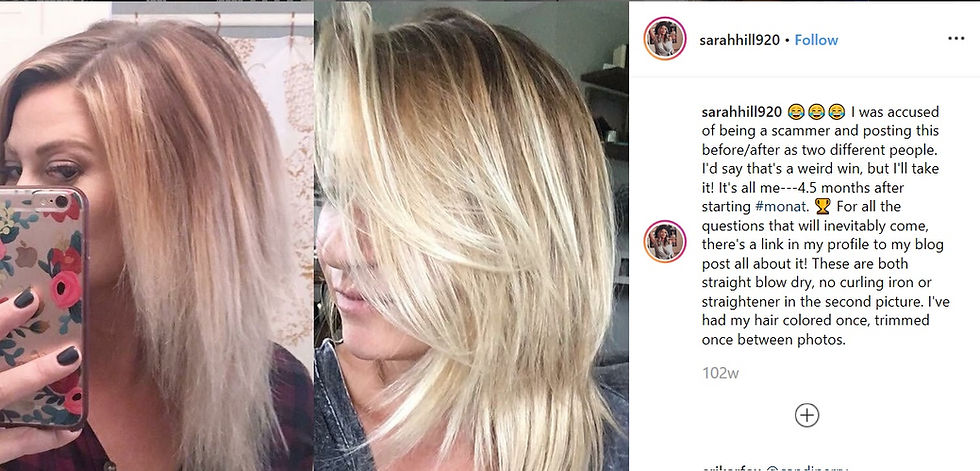Terrible company and products!!
- Dixie Dust
- Nov 1, 2018
- 3 min read

Trust Pilot Review
*copied with premission and added back the paragraph Monat asked to be removed.
If you value your health and hair please stay away! When you think about it you don't expect such an expensive product to be so terribly bad for you, so you don't do your research. I recommend to research the ingredients before you buy it.
So many people report hair loss, bald patches, irritated scalp and sores, acne, hormone imbalance (hence the hair fall out and acne) and even temporary infertility. It is mind-blowing!
I hope this gets banned in the UK!
PLEASE STAY AWAY!!!
Example: Monat Revive shampoo
Here are the ingredients that may coat the hair:
Guar Hydroxypropyltrimonium Chloride
Cinnamidopropyltrimonium Chloride
Stearyldimoniumhydroxypropyl Decylglucosides Chloride
Acrylates Copolymer
Sodium Hydroxypropylphosphate Laurylglucoside Crosspolymer
Propoxytetramethyl Piperdinyl Dimethicone
Centrimonium Chloride
I have not seen so many coating agents in one single shampoo including even Acrylates Copolymer that I normally see in nail polish as a film former and in hair sprays as a hair fixer.
There are two ingredients – Trideceth-6 and C11-15 Pareth-7 – that are made with a process called ethoxylation. What are the problems with this process?
---Monat asked this be removed--- To begin with, most manufacturers use harsh petrochemical raw materials. To make them less irritating to the skin, ethoxylation is used in which ethylene oxide is added.
As a result, traces of un-reacted ethylene oxide might be left in the final product. Moreover, 1,4-dioxane gets created during the ethoxylation process. Unless a manufacturer uses the vacuum-stripping method to get rid of 1,4-dioxane, the dangerous chemical can remain in the shampoo.
The International Agency for Research on Cancer has classified ethylene oxide as “carcinogenic to humans” and 1,4-dioxane as “probably carcinogenic to humans.” “Probably carcinogenic to humans” is defined by stating that “there is limited evidence of carcinogenicity in humans and sufficient evidence of carcinogenicity in experimental animals.”
Benzyl Alcohol
True, benzyl alcohol is an aromatic alcohol found in many naturally occurring plant products such as balsam of Peru. It is also a naturally occurring component of essential oils such as hyacinth, jasmine, and ylang-ylang oils and even of foods such as apricots, cranberries, cocoa, honey, mushrooms, and snap peas. However, when used in products, it is synthesized in labs by reacting benzyl chloride with sodium hydroxide.
In personal care products, it is often used as a preservative.
The Cosmetic Ingredient Review (CIR) has concluded that it is safe for use in cosmetic products, at concentrations of up to 5 percent, and up to 10 percent in hair dyes.
However, in the European Union, benzyl alcohol is allowed as a preservative in cosmetics and personal care products at a maximum concentration of 1%.
It is restricted because it may cause an allergic reaction. While it is rated higher (worse) (at 5 out of 10 being most toxic) in the Skin Deep database than CAPB (4 out of 10), according to the American Contact Dermatitis Society, it is recognized as a “weak” sensitizer. The American Contact Dermatitis society states that an allergic reaction to it is rare and a Belgian patch-test of 8,521 patients revealed that only 25 (0.3%) people had a positive reaction.
I do not have any information as to what concentrations of benzyl alcohol is used in the Monat Revive shampoo. My source is: https://ireadlabelsforyou.com/monat-revive-shampoo-review/?fbclid=IwAR3lE_maIzKas-8A4EnSMeKRsyB6S0zMJnc9sWcxwdDiMwBiOuvwBYkdB9E





Comments